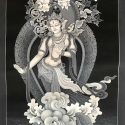Description
White Tara with Padmasambhava Thangka is hand-painted and is painted on Cotton Canvas in Kathmandu Nepal. White Tara is also known as Sita Tara.
White Tara is depicted in the center of thangka with Aparmita and Namgyalma in the bottom corner of the White Tara. Shakyamuni Buddha is presented at the top of the thangka. Lama teacher and Padmasambhava are presented at the top right and left corner of the thangka.
Iconography of White Tara
White Tara’s embodiment of peace is directed through loving compassion. From her serenity, she lends grace and dignity to situations and encourages the good to arise in all circumstances and situations.
The extra eye on her forehead, on the palms of her hands & the soles of her feet, represent her ability to see and understand the sufferings of all beings & her omniscient compassion toward the suffering.
Mantra of White Tara
The mantra of White Tara is Om Tare Tuttare Ture Mama Ayur Pune Gyana Puntin Kuru Swoha.
Iconography of Namgyalma
Ushnisha Vijaya is also known as Namgyalma. Namgyalma is a deity for long life and purification. Her mantra has infinite benefits.
It is said to be so powerful that anybody who hears it will never again be born from the womb. Therefore, if animals hear it, they will never again be reborn in the lower realms.
The mantra of Ushnisha Vijaya (Namgyalma)
Om Dhrum Soha Om Amrita Ayur Dade Soha
Icnography of Aparmita
Buddha Aparimita is very popular in bestowing long life upon the devotees. It is red in color. His two hands are in dhyana mudra and hold an ambrosia vase.
He usually wears all the ornaments of different kinds peculiar to a Sambhogakaya Buddha. He is never depicted with any consort. He wears a crown and has Ushnisha and Urnakosh in his body.
Buddha Aparimita is invoked or worshipped for lengthening the life span or fast relief from dreadful diseases or from mortal danger.
In the Nepalese Mahayana tradition, the dharani of Buddha Aparimita is often recited by the devotees in the presence of dying patients the recitation of this dharani is said to be efficacious when carried out in utter sincerity.
It is said that the famous Madhyamika Buddhist philosopher Arya Nagarjuna had escaped his early death after the recitation of this dharani for one complete day and night.
The mantra of Buddha Aparmita
Om A Ma Ra Ni Dzi Wan Ti Ye Soha
Iconography of Padmasambhava
Padmasambhava is presented at the top left corner of the painting. The Khatvanga, a danda with three severed heads denoting the three kayas (the three bodies of a Buddha: the dharmakaya, sambhogakaya, and nirmanakaya), crowned by a Trishula and dressed in a sash of the Himalayan Rainbow or Five Pure Lights of the Mahabhuta is a particular divine attribute of Padmasambhava and intrinsic to his iconographic representation.
His two eyes are wide open in a piercing gaze. On his body, he wears a white vajra undergarment and, on top of this, in layers, a red robe, a dark blue Mantrayana tunic, a red monastic shawl decorated with a golden flower pattern, and a maroon cloak of silk brocade. He has one face and two hands.
In his right hand, he holds a five-pronged vajra at his heart; and in his left, which rests in the gesture of equanimity, he holds a skull-cup in the center of which is a vase of longevity filled with the nectar of deathless wisdom. Cradled in his left arm is a three-pointed Khatvanga representing the consort Mandarava. On his head, he wears a five-petalled lotus hat.
Wrathful and smiling, he blazes magnificently with the splendor of the major and minor marks. He is seated with his two feet in the royal posture.
Mantra of Padmasambhava
The mantra of Padmasambhava is Om Ah Hum Vajra Guru Padma Siddhi Hum.
Iconograpy of Shakyamuni
Shakyamuni Buddha is presented at the top of the thangka. His left hand is in the lap holding a begging bowl while the right arm is extended across the leg with the fingers touching the earth.
His skin is golden in color, the eyes partially closed and the hair piled with a gold ornament adorning the top of the head.
A dot (bindi or “urna”) between the eyebrows and the earlobes are elongated and pierced. The shoulders are covered with an orange and red robe wrapped around the torso and legs and tied at the waist with a green sash.
Mantra of Shakyamuni
The mantra of Shakyamuni is Om Muni Muni Maha Muniye Soha.










































Reviews
There are no reviews yet.